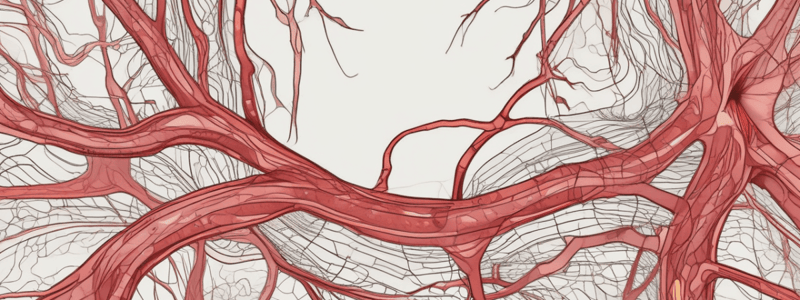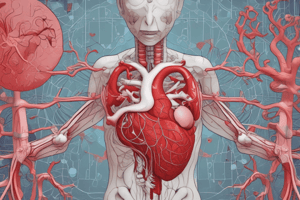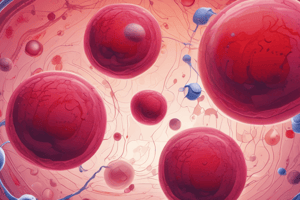Podcast
Questions and Answers
What is the term used to describe the layer composed of endothelial cells and the basement membrane?
What is the term used to describe the layer composed of endothelial cells and the basement membrane?
- Tunica Media
- Tunica Intima (correct)
- Basement Membrane
- Tunica Externa
What type of muscle cells are found in the Tunica Media layer?
What type of muscle cells are found in the Tunica Media layer?
- Epithelial Cells
- Skeletal Muscle Cells
- Cardiac Muscle Cells
- Smooth Muscle Cells (correct)
What is the main function of the basement membrane?
What is the main function of the basement membrane?
- To regulate blood pressure
- To act as a scaffold for endothelial cells (correct)
- To create a barrier for blood flow
- To produce collagen
What is the term for the outermost layer of blood vessels?
What is the term for the outermost layer of blood vessels?
What is the primary component of the basement membrane?
What is the primary component of the basement membrane?
What is the function of endothelial cells in blood vessels?
What is the function of endothelial cells in blood vessels?
What is the purpose of the Tunica Intima layer?
What is the purpose of the Tunica Intima layer?
What is the origin of the term 'Tunica Intima'?
What is the origin of the term 'Tunica Intima'?
What is the main function of elastin protein in large and middle-sized arteries?
What is the main function of elastin protein in large and middle-sized arteries?
Which vessel type has a thin layer of smooth muscle in the tunica media?
Which vessel type has a thin layer of smooth muscle in the tunica media?
What is the term for the small blood vessels that supply blood to large vessels?
What is the term for the small blood vessels that supply blood to large vessels?
Which layer of the vessel has nerve endings?
Which layer of the vessel has nerve endings?
What is the main difference between large and middle-sized arteries and small arteries and arterioles?
What is the main difference between large and middle-sized arteries and small arteries and arterioles?
Which vessel type has three layers: tunica intima, tunica media, and tunica externa?
Which vessel type has three layers: tunica intima, tunica media, and tunica externa?
What is the purpose of the tunica externa layer in large vessels?
What is the purpose of the tunica externa layer in large vessels?
Which protein is abundant in the tunica externa layer?
Which protein is abundant in the tunica externa layer?
What is the main characteristic of the tunica media layer in small arteries and arterioles?
What is the main characteristic of the tunica media layer in small arteries and arterioles?
What is another term for the tunica externa layer?
What is another term for the tunica externa layer?
What is the primary function of the small arteries and arterioles?
What is the primary function of the small arteries and arterioles?
What is unique about the structure of capillaries?
What is unique about the structure of capillaries?
What is the purpose of the tunica externa in small arteries and arterioles?
What is the purpose of the tunica externa in small arteries and arterioles?
What is the main difference between the structure of veins and arteries?
What is the main difference between the structure of veins and arteries?
What is the function of the muscle in the tunica media of small arteries and arterioles?
What is the function of the muscle in the tunica media of small arteries and arterioles?
What is the role of the vasa vasorum in the tunica externa?
What is the role of the vasa vasorum in the tunica externa?
What is the primary function of the capillaries?
What is the primary function of the capillaries?
What is the characteristic of the tunica media in large and middle arteries?
What is the characteristic of the tunica media in large and middle arteries?
Flashcards are hidden until you start studying
Study Notes
Blood Vessels
- A blood vessel has three layers: Tunica Intima, Tunica Media, and Tunica Externa.
Tunica Intima
- The innermost layer of a blood vessel, consisting of endothelial cells and a basement membrane.
- Endothelial cells are the first cells that blood interacts with.
- The basement membrane is a thin layer of protein that keeps everything in place, containing proteins like collagen.
Tunica Media
- The middle layer of a blood vessel, consisting of smooth muscle cells.
- In large and middle-sized arteries, this layer is larger and contains elastin protein, making the arteries more elastic to handle high pressures.
- In small arteries and arterioles, this layer has a lot of smooth muscle, allowing for constriction to create resistance and change blood pressure.
Tunica Externa
- The outermost layer of a blood vessel, consisting of protein.
- Contains collagen and other proteins.
- Also known as Adventitia.
- In large vessels, this layer has vasa vasorum (small blood vessels) and nerve endings.
Veins
- Follow the general pattern of three layers (Tunica Intima, Tunica Media, and Tunica Externa).
- Have a thin layer of smooth muscle in the Tunica Media.
Arteries
- Can be divided into large and middle-sized arteries, and small arteries and arterioles.
- Large and middle-sized arteries have a larger Tunica Media with elastin protein, making them more elastic.
- Small arteries and arterioles have a larger Tunica Media with more smooth muscle, allowing for constriction to create resistance.
Capillaries
- Have only one layer, consisting of a single endothelial cell that forms the entire wall of the tube.
- Are unique in that they allow for the exchange of substances between the blood and surrounding tissues.
Studying That Suits You
Use AI to generate personalized quizzes and flashcards to suit your learning preferences.



